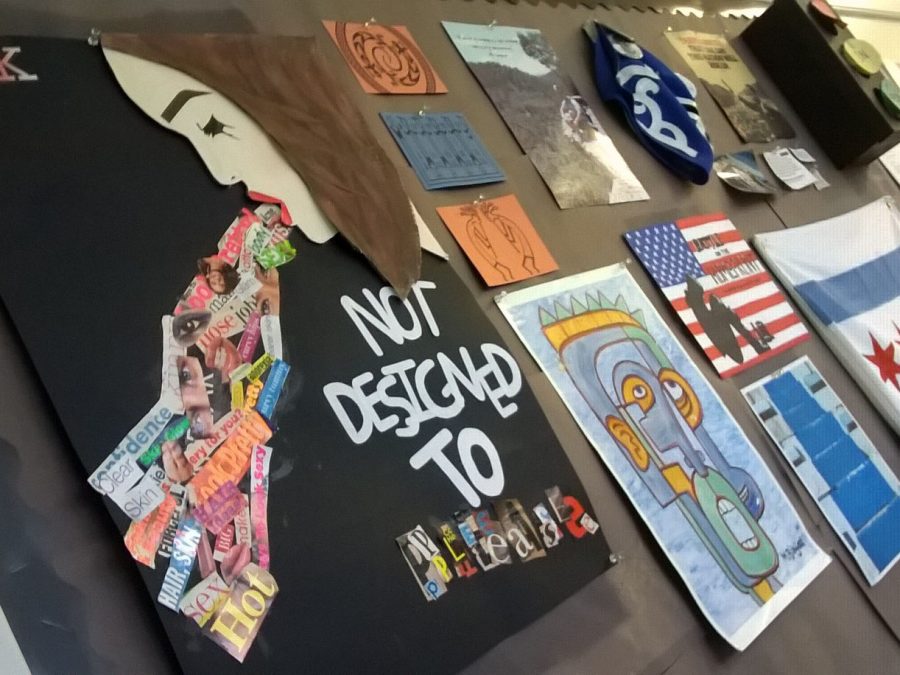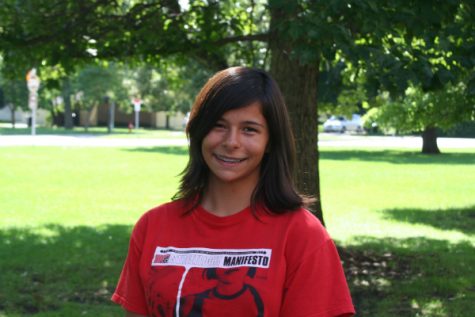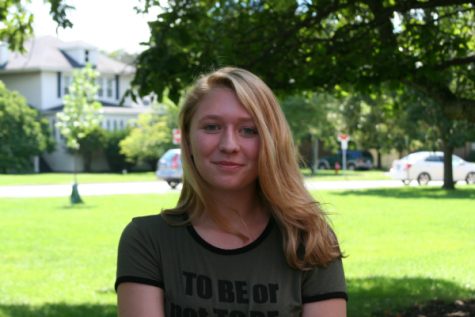Upstander projects: Making a Change
April 13, 2017
RB sophomore Upstanders of 2017 rise to make a change, raising awareness to current local and global social and environmental issues.
The Upstander Projects are projects assigned by a few sophomore english teachers, encouraging their students to research social issues and then apply their research to making a constructive contribution to their topic.
“[We are] better[ing] the society in our own individual ways,” said sophomore Upstander, Analiz Nunez.
Students brainstormed ways to draw attention to their topics, ranging broadly. Sophomore honors english teacher, Bridget Wilmot, assigned her students to begin by researching their topic, and then figure ways to raise awareness.
“There are a variety of projects: some who are fundraising, some who are holding drives, some are volunteering, some are creating events, some are building websites. That’s most of it at least,” said Wilmot.
Nunez’s group chose a topic RB students themselves could possibly be affected by and relate to.
“[We chose] stigma against homophobia and how parents don’t teach their children about it,” said Nunez.
Similarly to the Upstander projects, John Izaguirre, a sophomore honors english teacher, draws attention to global social and environmental issues through his Fight the Power projects.
“[My students] are “fighting the power” on a topic that no one is talking about and want to shine a light on,” said Izaguirre.
Topics widely range from internet safety to body shaming, homeless veterans to human trafficking.
His students have a week and a half to complete their research, and are assigned to build a presentation for their class. Each group teaches the class about their topic for a full period. Later on, students design creative and artistic works, such as posters, to draw attention to their topics.
“The research, the presentation, and then making something creative are all parts of the project,” said Izaguirre. “There’s bits and pieces for every student, so they can all get involved in some way.”
Students get involved and become passionate about their topics. Izaguirre explained that once students begin researching an issue, the more passionate they become to wanting to resolve it.
“This helps students become socially aware of what’s going on in the [world they are living in and] should really know about,” said Izaguirre.





Stefani Gonzalez • May 2, 2017 at 4:47 pm
Dear Nicolette O’Keefe, Madelyn Jones, and Chynna Simon,
Hi, my name is Stefani Gonzalez and I am a sophomore at RB. I am a member of Orchesis, FCCLA and I’m in Ms. Wilmot’s 5th period class. I saw your article about the Upstander Project and I wanted to tell you more about my project and social issue.
My topic is Nosocomephobia, otherwise known as the fear of hospitalization, and it is a widely prevalent phobia in medical facilities, like hospitals and senior homes, around the world. According to Diane Dekany, a Child Life Specialist at Mercy Children’s Hospital, it’s the fear of needles and medical tests that frighten patients the most, not the illness or surgeries themselves. These seemingly odd and invasive tests have the ability to heighten anxiety and fear in the patients, due to their frightening nature. However this fear can also be drawn from a traumatic experience that the patient has endured or even their fear of germs. Some of the symptoms include anxiety, panic attacks, nausea, and elevated heart rate.
Clearly these symptoms should not be taken lightly since during a patient’s time of illness, they endure enough stress and pain from the various medicals procedures being done to them already. If we allow patients to continue fearing medical assistance, we’re unleashing the unrelenting panic that ensues whenever they face medical aid. The panic that arises when they see a glittering needle poke through their skin. The fear that appears when they’re wheeled into a surgical room and instructed to breathe as the mask envelops their mouth. Or the fear that comes when the uncertainty of their life lies in the hands of their caretakers. This anxiety is especially prevalent in children, as a result of their wild imaginations. However this phobia still significantly affects patients from all age groups. Patients who have no control over their medical situation and do not ask for cancer or old age to strip them of their health. So we cannot let them suffer more than they already are. It’s our job to make sure that we reduce their fear of medical assistance so that they can live a happier life.
Since the fear of medical facilities is such an important issue to face, I chose to make a positive social change to help eliminate it. For my project, I decided to lead an Easter craft session at a nearby senior home, called The Scottish Home. After talking to the activity director at the home, we decided that we would help the seniors make bunny silhouette paintings. After we set a date, I gathered the materials and created a sample to show to the residents. Once the day came, I showed the residents what to do and let them paint. The results were absolutely incredible and the residents seemed to enjoy it because by the end of the craft, they were all talking to friends, smiling, and laughing.
I hope that people will start to acknowledge the importance of this social issue and do something about it. Perhaps hold a craft session of your own, talk to patients about their feelings, visit loved ones in hospitals, but most importantly, try to make everyone comfortable and stress free. Reducing the fear of hospitalization may seem impossible, but with every stride we take to ending it, the closer we get to achieving our goal.
Sincerely,
Stefani Gonzalez
Analiz Nunez • May 2, 2017 at 1:10 pm
Dear Nicky, Maddy, and Chynna
I am a sophomore student in Ms. Wilmot’s Honors English class. I’m in band and Eco Club. My purpose of this project is to raise awareness and tolerance/ acceptance of the lgbt+ community.
Liking the opposite gender and conforming to stereotypes, which would be girls liking pink and flowers and drawing, boys like blue and sports and rough housing, etc., is sort of heavily pressured on kids in everything they do. You don’t hear adults or children joking around when two girls are playing together, teasing “oh is that your girlfriend” as much as a girl and a boy playing together and the boy being asked the same question. People also don’t really take kids seriously, or even teens, when they actually show interest in the same gender, saying it’s “just a phase” or they’re “confused” or are “too young to know“ what they like. Some people may even go as far as treated being gay as an actual illness. Gay teens are taken to mental health counselors for “gay conversion therapy” in attempts to change their orientation.
People are people no matter who they love or want to be and shouldn’t have to face these kinds of things and discrimination. What one person loves or is doesn’t effect nor shouldn’t matter to someone they don’t really know. Someone, Person A, who enjoys movies over books, being upset and aggressive towards Person B, who prefers to read books over watching movies, is the same ideology as homophobia: irrational and incompetent. Person B’s differing opinion doesn’t hurt or affect Person A in any way, and the same goes for any gay couple. Why are gays seen as tainting and threatening to traditional society and order, when homophobes are forcing heteronormativity and going so far as to killing people of the lgbt+ community, like the shooting that happened in Orlando, Florida last year, resulting in 50 deaths. Imagine that, finding out that your child’s life was taken by a man, who you don’t even know, all because your child loved someone. That some man was so hateful and against your child’s happiness and orientation; someone so hateful and against love. Studies have show that lgbt+ teens’s attempt at suicide is at a rate that is two to six times greater, as well as a higher rate of alcohol/drug abuse, and are at greater risk for school failure.
My solution to this was to introduce kids to being gay. Sounds weird, but I know as a kid I didn’t know that being gay was a thing or even allowed per say. It was as if liking the opposite gender was a rule or a given task that needed to be carried out, and it was just assumed. Although, this isn’t like propaganda or anything to convert the little, hetero kids to homosexuality, this is just to let them know that maybe that weird feeling for that really pretty girl isn’t being envious of how she looks, it may be that you like, like her.
So now, I decided to create a story to show children, in the form of a story so that they’d be more interested in what i’m saying, and hopefully take something from it, as well as for those who read about my social issue, and become less prejudiced. Being gay is okay, it even rhymes.
Carina Sandoval • May 2, 2017 at 1:09 pm
Dear Nicolette, Madelyn, and Chynna,
I am a sophomore here at RB, and I’m currently involved in Band, Girls Who Code, Eco-Club, and an out of school organization called the Chicago Children’s Choir, within the top level, the Voice of Chicago. I am a student in Ms. Wilmot’s 5th period Honors English class, and I am apart of the Upstander projects taking place. .
In the school-to-prison pipeline, funding for the prison industry and correction institutions have grown much more than that of education, and many schools are lacking necessary materials to help their students succeed. According to Mike Kennedy from American School and University, state and local higher education funding per student fell by 28 percent, while per capita spending on corrections increased by 44 percent. These schools happen to be in low income neighborhoods, filled with many students who are homeless or are facing difficulty at home, not in higher income neighborhoods. As reported by the ACLU of California, the punishment in these schools is much harsher than that of a higher income neighborhoods, and it is often times handled by the police rather than school administrators, who tend to distribute unnecessary consequences for minor offenses. The security in these schools is very high, and they happen to be fairly aggressive and will hand out punishments for fairly minor things, like talking back, due to their zero tolerance policies.
When a child receives a suspension, their chances of graduating greatly decrease, and this eventually leads to the minor dropping out of school, either to help provide for their families and go immediately into work or do become increasingly susceptible to crime and drugs. Some of the punishments even include in-school arrests, possibly leading to the child ending up in a juvenile detention facility, but in some situations these children are tried as adults, receiving once again harsher punishments and are being exposed to even more violence.
This situation greatly affects students of color and with disabilities, and have a much higher risk of being expelled than their white, non-disabled counterparts. Their punishments are much harsher, due to their racial stereotypes and where they happen to live, because somewhere in history these children were thought of to be less than other children, and incapable of more. This leads to the much bigger topic of hyper or mass incarceration.
My solution to creating positive social change was to participate in the drive week, with my drive being for school supplies to donate to the Operation Backpack Foundation. This foundation provides backpacks to children in need, as it not only greatly helps their family but also helps them in being able to succeed. I’m also in the process of creating a stimulation or workshop with the students in my class, which I might open up to other classes that would potentially be interested. This was more for creating awareness about the subject, by not only informing but by also giving a sense of the unfairness that seems to be happening within the school system. I encourage students to donate to my drive and any other drives aimed at providing materials for students in need, along with spreading awareness and calling local representatives to help change any laws.
Thank you,
Carina
Nadia Valencia • May 2, 2017 at 1:09 pm
Dear Nicolette O’Keefe, Madelyn Jones, and Chynna Simon, the reason I am writing this letter is to raise awareness for animal abandonment. I wanted to add more information to the clarion article about this social issue because I feel as if too many animals are being neglected for the utmost inappropriate way.
Everyone grew up with meat to eat and going to zoos or circuses, but who has thought of the impact upon those animals. Now you question yourself why should animals have rights? There are numerous ways of how animals help each individual, but most of all these creatures assists people who do not have anyone. Pets serve many purposes to their owners, that being a service pet to a ‘man’s best friend’. Better yet, being an owner could boost your health because Humana explains that just stroking a cat or dog can make you feel calm and increase the feel-good chemicals, serotonin and dopamine, in your brain. Despite that, we take animals for granted when they just want an owner who is loyal and warmhearted. Us humans do not have the audacity to even recognize for the slightest bit that animals have no call for help but yet we have the neediness to take and not give back.
According to the Humane Society, an organization that aims to end animal suffering, about “80% of dogs and cats are being adopted from shelters or rescues”, but the other 20% are dogs and cats that are helpless without someone looking after them. People for the Ethical Treatment for Animals (PETA), the largest non profit animal rights organization in the world, states that “every year in the U.S., more than 6 million lost, abandoned, or unwanted dogs and cats enter animal shelters”. Many of the pets being thrown out by their frustrated owners will then be in puppy mills where they will live for the rest of their lives in small crates without getting fresh air, living on sides of roads, or be saved by rescue groups. These absorbing facts of animal abandonment should show just how much of an issue this is because more than half of those deserted pets could be useful to someone who needs the unconditional love from the voiceless.
The Chicago Animal Care and Control (CACC) need all the help they can receive since it is run by the city and the needs of the powerless creatures are not the main priority, but the majority of the supervision and help is from kind-hearted volunteers who take time out of their own lives. My goal is to help by giving the most supply I could possibly collect in order to at least ease the necessities that they are in greatest need of. Creating awareness as a whole could be potential growth into increasing the recognition of animal abandonment and animal care.
Whoever you are, wherever you are, you can help just by signing petitions against animal cruelty to even giving a stray dog or cat a second chance at life.
Sincerely, Nadia Valencia
Noah Hoadley • May 2, 2017 at 1:08 pm
To Nicolette, Madelyn, and Chynna, I am a sophomore at RB, and I’m heavily involved in the music department and tech crew here. I am in Ms. Wilmot’s Honors English class, and I saw the recent article about the Upstander Project, and was wondering if I’d be able to add some more insight to it.
The main issue that my project worked to solve was animal abandonment, abuse, and overcrowding in shelters. Many animals are abused by their owners, and are subjected to massive torment and torture. Others are abandoned on the streets to fend for themselves. The lucky ones are picked up by shelters. However, many are overcrowded, and therefore sickness is rampant. Other shelters, which are no kill, turn away animals they deem unable to be adopted. That means that they are left with owners who don’t want them. Animals who aren’t get adopted either die, or are euthanised because of overcrowding.
The needless loss of life is quite disheartening. The amount of animals this effects is massive. According to research by PETA, which is an organization that promotes fair treatment of animals, over 6 million abused, abandoned, and unwanted animals enter shelters every year. Almost HALF of those animals are euthanized every year. This statistic completely staggers me. Another major cause of this overpopulation and euthanization is that Instead of adopting these millions of homeless animals, people instead decide to buy their pets and animals from pet stores and other places such as puppy mills, where the animals are practically mass produced.
Our goal was to lessen the suffering of the countless animals that face all of this every year. We planned to raise awareness and money for the shelters through fundraising and other means. Our original plan was to bring in the animals themselves and have people pay a small fee to hang out and play with them, which would then be donated back to the shelters, however this never panned out. Instead, we’ve been collecting spare change from people in the lunch periods. Other ways to support these shelters and the animals that the help, you can donate money and even volunteer at the shelters if they need help. In conclusion, please help these animals that die and are killed every year because of these problems. They need your help.
Best wishes,
Noah Hoadley